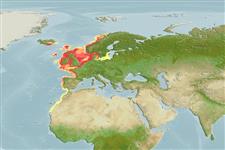Common names from other countries
Classification / Names / Names
ชื่อสามัญ | ชื่อพ้อง | Catalog of Fishes (gen., sp.) | ITIS | CoL | WoRMS
Environment: milieu / climate zone / depth range / distribution range
นิเวศวิทยา
; กร่อย; ระดับความลึก 0 - 200 m (Ref. 2779), usually 0 - 6 m (Ref. 114208). Subtropical; -1°C - 22°C (Ref. 114208), preferred 12°C (Ref. 107945); 70°N - 22°N, 20°W - 19°E (Ref. 114232)
Eastern Atlantic: From Great Britain north to Iceland, the North Sea and Norway, south to Portugal and Spain to Mauritania. Introduced and established in North America, South Africa (Cape Town), and Australia. Introduced but not established in Panama, Brazil, Pakistan, Sri Lanka, Madagascar, Myanmar, Japan and Hawaii. Subtropical to polar.
Length at first maturity / ขนาด / น้ำหนัก / Age
Maturity: Lm ?, range 1 - 4.5 cm Max length : 6.0 cm CL เพศผู้/กระเทย; (Ref. 435); common length : 4.0 cm CL เพศผู้/กระเทย; (Ref. 435); อายุสูงสุดที่ได้รายงาน: 7 ปี (Ref. 128193)
Usually found in eelgrass beds (Ref. 128717). Maximum carapace width: 7.7 cm; commonly 5 cm wide.
Members of the order Decapoda are mostly gonochoric. Mating behavior: Precopulatory courtship ritual is common (through olfactory and tactile cues); usually indirect sperm transfer (Ref. 833). Berried females migrate from littoral areas to more saline and deeper water (8-10 m) until hatching of eggs; afterwhich, they go back to moult and copulate (Ref. 128197). Larger females can breed twice or thrice annually (Ref. 128203).
Fischer, W., G. Bianchi and W.B. Scott (eds.). 1981. (Ref. 435)
IUCN Red List Status (Ref. 130435: Version 2024-1)
CITES status (Ref. 108899)
Not Evaluated
Not Evaluated
Human uses
การประมง: การค้า
FAO - การประมง: landings | FishSource | ทะเลรอบๆเรา
เครื่องมือ
แหล่งที่มาจากอินเตอร์เน็ต
Estimates based on models
Preferred temperature
(Ref.
115969): 7 - 12.7, mean 9.6 (based on 453 cells).
Vulnerability
Low to moderate vulnerability (28 of 100).
